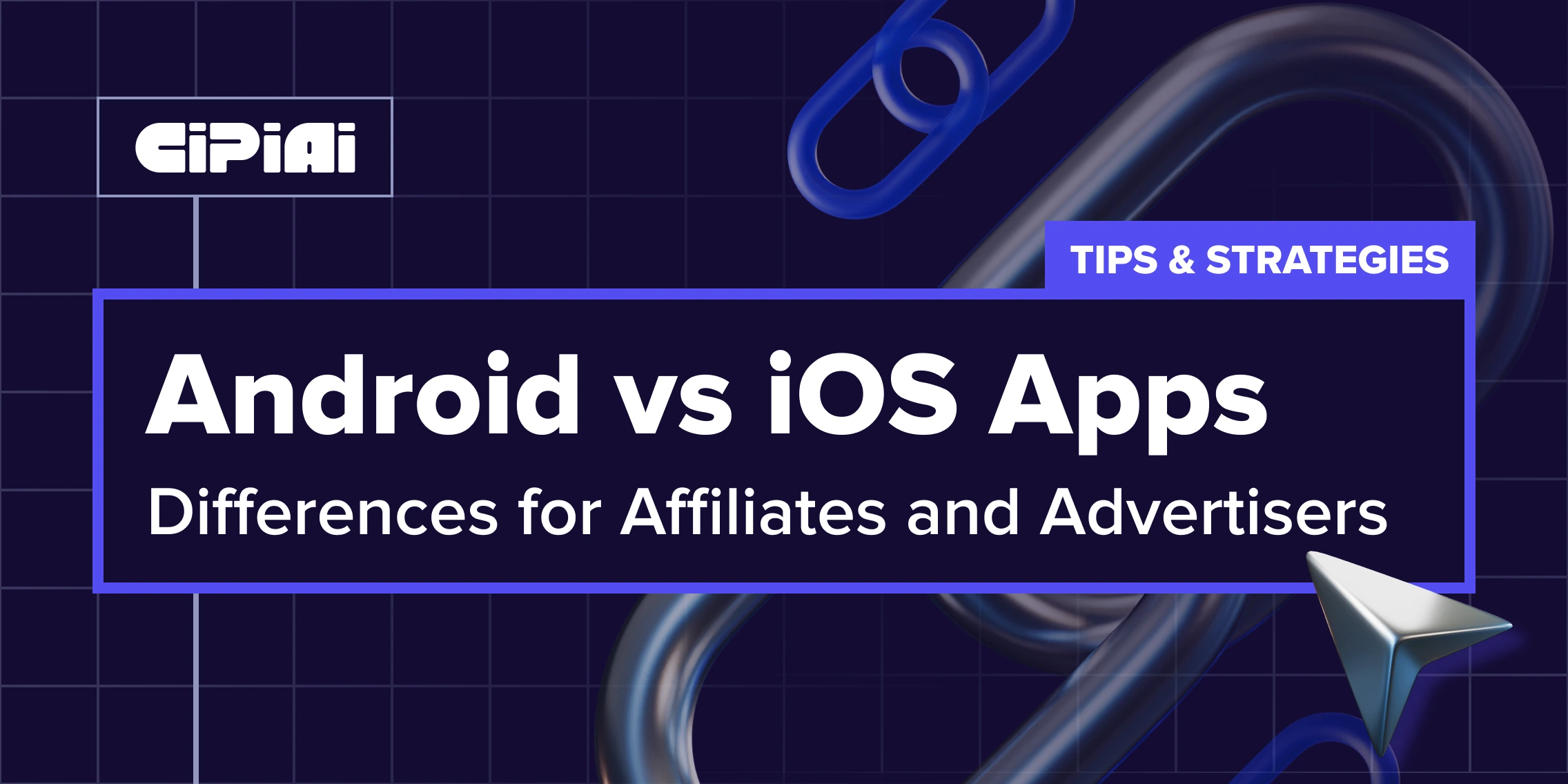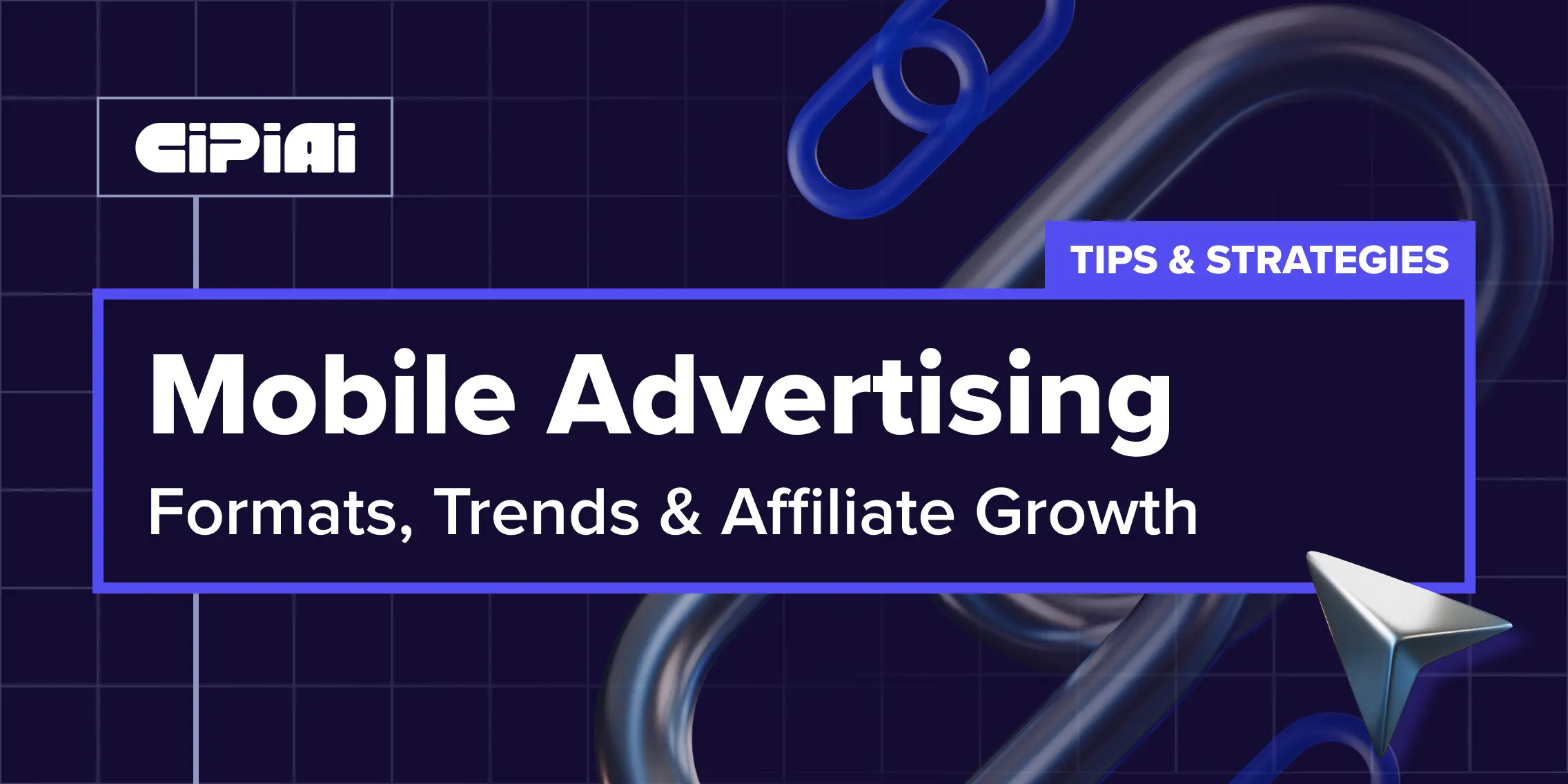
Android vs iOS Apps in Affiliate Marketing: What Marketers Need to Know
Compare Android and iOS app campaigns in affiliate marketing — payouts, tracking, GEOs, and conversion flows explained by CIPIAI.

Believe it or not, mobile advertising isn’t just “ads on your phone” in the everyday sense — it’s become a rich, layered ecosystem, and yes, we think it’s more important than ever.
To start: according to Investopedia, mobile advertising is defined as “any form of advertising that appears on mobile devices such as smartphones and tablet computers.”
So – at its core: ads delivered via mobile devices, separate (but overlapping) with mobile marketing and mobile apps.
Now — why should we care in 2025? Because the numbers are screaming it. For instance: projections show the global mobile advertising market will hit around US$447 billion in 2025, accounting for about 56% of total digital ad spend.
That’s not a footnote – that’s a major shift. If over half of all digital ad budgets are destined for mobile, ignoring this channel means ignoring where the action is.
And deeper still: mobile isn’t just “smaller screen, same ad” — it’s evolving under the heat of AI-personalisation, privacy regulation, and user behaviour changes. For example: more spending is going into in-app formats (as opposed to classic mobile web banners) — and thus mobile ad ROI becomes tied to user context, device behaviour, and intent. One report notes that global in-app ad spending is expected to reach about US$390 billion in 2025.
Thus, the “why it matters” is three-fold:
So if you’re an affiliate marketer, publisher, app-growth specialist — yes, you should lean in. Treat mobile advertising not as a side channel, but as the main stage for many campaigns in 2025.
Let’s unravel the most common mobile ad formats — the kind you bump into every time you swipe, tap, game or kill time on your phone. (Yes, they’re everywhere.) I’ll map out each type, what it is, when it works best — and especially how it stacks up for affiliates.
It’s not just “ads on phones” anymore. The ad industry is in the middle of a pivot-turn. On one side: privacy is tightening its grip. On the other: AI is stepping in to fill gaps and push performance. Let’s walk through three major themes—then discuss what they mean for affiliates and mobile publishers.
If you recall, App Tracking Transparency (ATT) on iOS already forced marketers to rethink how they target users — now Google’s Android version, the Privacy Sandbox, seeks to do something similar for Android: remove or heavily limit reliance on device IDs (like GAID) and cross-app tracking.
For example: Google states that the Android Privacy Sandbox “will minimise (and potentially remove) use of the Advertising ID” to help preserve user privacy while still enabling mobile advertising.
What that means in practice:
While privacy walls rise, AI is stepping up to help fill the void. According to a June 2025 trend article by SmartyAds: “AI transforms mobile advertising through real-time bid optimisation, predictive analytics, and automated campaign management.”
More specific: AdCreative.ai (and others) report that generative AI and dynamic creative optimisation (DCO) are becoming table-stakes — marketers now test thousands of creative variations, micro-target audiences in real time, and let the AI pick the winners.
What this means:
With identifiers fading and privacy regs tightening, affiliate networks and traffic sources must adapt. One key adaptation: shift from client-side tracking to server-to-server (S2S) postback flows and use measurement systems that don’t require leaking personal identifiers. (This is the model used by networks such as CIPIAI).
Why does this matter? Because as device-ID based tracking loses reliability, you’ll need:
In short: The future of mobile ad buying is shifting from “spray & pray device-IDs” toward “privacy-safe signals + smart creative + server-side tracking”. Affiliates who cling to old models (device ID > click > conversion) without upgrading are likely to see performance fall. But those who adapt now — investing in AI creative tools, more robust tracking, and privacy-first measurement — will be well-positioned for 2025 and beyond
Let’s dig into how mobile ad formats are actually performing right now — and what that means for affiliates, publishers and app marketers. (Yes, I know you’ll want the numbers.)
Here’s a snapshot of recent research:
Key take-aways for affiliates/publishers:
Here’s how you might visualise performance benchmarks by ad format
*CPC values are approximate and will vary widely by geography, traffic source and vertical.
From the vantage-point of an affiliate network (such as CIPIAI) and app-traffic flows:
Alright — let’s get practical. If you’re in the affiliate game or driving app installs, here are three smart levers to pull when you’re using mobile ad formats + offer flows in 2025 (with a spotlight on how CIPIAI comes into play).
Different offer models call for different ad-formats. Match them well and you’ll squeeze more out of the budget (and avoid wasted clicks). Here’s how you might line it up:
By aligning like this, you avoid the mismatch where you push a high-volume CPI offer via tiny banners that no one notices. Instead you pick the right format for the model.
Now — where do you place those ads? Again: pick your sources based on offer type, GEO, device, and format. Here are some high-lever sources in 2025:
For example: if you’re promoting a utility app (VPN/cleaner) in a Tier-2 GEO via Android, you might use push or in-app native traffic. If you’re pushing a premium iOS game in the US, maybe UAC + playable ads + direct app store link.
Here’s where CIPIAI plugs in — and why it matters for mobile advertising and affiliates.
So if you’re an affiliate or app dev: using a network like CIPIAI means you don’t have to piece everything together yourself from traffic source → offer → OS → tracking. You get a partner that understands mobile advertising nuances.

If you want to win with mobile advertising as an affiliate/app marketer in 2025, think of three dimensions:
Mix those wisely, test fast, optimise harder — and you’ll be much better positioned than folks who just throw banners everywhere and hope.
The mobile-ad landscape is shifting fast. If you’re not watching ahead, you’ll be playing catch-up. Below are four major trends shaping the next wave of mobile advertising — and yes, they’re relevant for affiliates, app-marketers and publishers alike.
Already we’re past the phase where AI helped just with bidding. Today, AI is helping create the ads themselves — visuals, copy, variant testing — all at scale. For example, companies like AdCreative.ai report that AI-generated ad creatives can outperform traditional designs by significant margins.
What this means in practice:
The “buying ads” side is also evolving. The old cookie-based, device-ID heavy models are fading (thanks privacy + regulation). What’s rising: programmatic systems that blend first-party data, contextual signals and real-time bidding. For example, an article on programmatic trends in 2025 describes “attention-based measurement”, “AI tools”, “dynamic creative optimisation” and the decline of reliance on cookies.
For mobile-app affiliates & marketers this means:
We’re entering a phase where “mobile ad” isn’t just a banner or interstitial.
Finally, and perhaps most importantly: the metrics game is going deeper. Thanks to generative AI and advanced data models, you’re not just looking at “click → install → payout”. You’re predicting user lifetime value, churn risk, quality of installs, and optimizing your spend accordingly. For example, generative frameworks in advertising systems aim to integrate creative generation, bidding, allocation and payment optimisation.
What to watch:
For affiliates and app-marketers: your margin will increasingly depend not just on how many installs you drive, but on how quality those installs are, how well you optimise in-flight, and how smart your data play is.
These four trends aren’t isolated — they reinforce each other. AI-generated creative works best when you have strong contextual/first-party data; programmatic hybrid bidding benefits from predictive analytics; emerging formats demand better measurement & optimisation.
So, where does all that leave us? In short: mobile advertising in 2025 isn’t “just ads on phones” anymore. It’s an intricate ecosystem of formats, algorithms, privacy policies, and creative battles all competing for the same two inches of screen space.
We’ve seen how banner ads still hold their ground for awareness, while playable and rewarded formats dominate engagement and conversion. We’ve talked about the privacy squeeze — how Apple’s ATT and Google’s Privacy Sandbox changed the rules—and how AI swooped in to keep campaigns efficient through predictive optimization. And, of course, we’ve touched on the subtle but critical split between Android’s scale and iOS’s premium performance.
For affiliates and app marketers, the pattern is clear:
The bottom line? Mobile advertising is now a blend of art, data, and timing. Those who learn to weave all three—affiliates, app developers, SaaS marketers—are the ones who’ll keep scaling while others chase yesterday’s clicks.
And if you’re looking for a place to start (or a partner that already gets it):
Join CIPIAI — monetize your mobile traffic through direct, high-performing offers with weekly payouts and transparent tracking.
Because in 2025, speed and reliability aren’t perks. They’re survival tools.
It depends on your goal, but playable and rewarded video ads consistently lead in engagement and ROI. They combine entertainment with intent — users choose to interact, which filters out low-quality clicks. For awareness, native and interstitials still perform well when the creative is smartly matched to context.
Surprisingly, yes — when done with purpose. Banners are cheap, easy to scale, and perfect for retargeting or frequency building. But they can’t carry a full conversion campaign. Think of them as gentle reminders, not primary drivers.
Radically. Advertisers can’t rely on cross-app IDs or device fingerprints anymore. Instead, they’re learning to use cohort-based or contextual targeting. Attribution moved from click-based to aggregated reporting. The smart players — including networks like CIPIAI — now rely on server-side postback tracking to stay both compliant and accurate.
Benchmarks vary, but as of this year:
There’s no single answer — but UAC (Google), native ad platforms, and Reddit Ads currently top the list for compliance, reach, and creative flexibility. Push and in-app traffic are still fantastic for volume in emerging GEOs, especially on Android.
Because they simplify the chaos. CIPIAI acts as a bridge between developers and publishers, offering direct CPI/CPA/RevShare deals, built-in tracking, and weekly payouts. Instead of juggling ten dashboards and compliance checks, affiliates can focus on testing, optimizing, and scaling.
The next few years will bring more AI-driven creative generation, predictive targeting, and immersive ad formats (think AR and shoppable video). The winners will be those who blend automation with storytelling — people who understand data but still write like humans.
Copyright © 2025. Bisdev Solutions Limited
All rights reserved